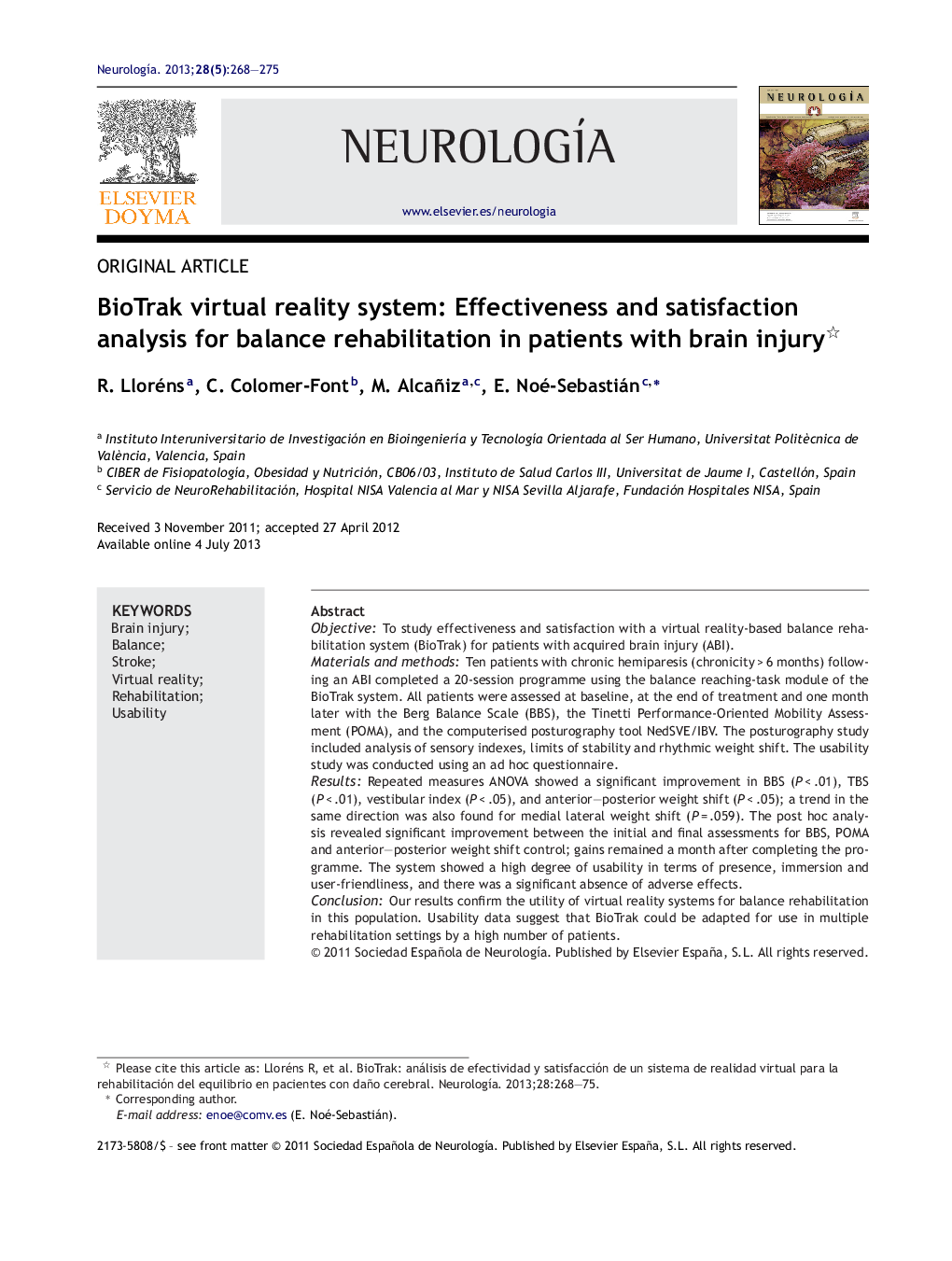| کد مقاله | کد نشریه | سال انتشار | مقاله انگلیسی | نسخه تمام متن |
|---|---|---|---|---|
| 3077342 | 1189137 | 2013 | 8 صفحه PDF | دانلود رایگان |

ObjectiveTo study effectiveness and satisfaction with a virtual reality-based balance rehabilitation system (BioTrak) for patients with acquired brain injury (ABI).Materials and methodsTen patients with chronic hemiparesis (chronicity > 6 months) following an ABI completed a 20-session programme using the balance reaching-task module of the BioTrak system. All patients were assessed at baseline, at the end of treatment and one month later with the Berg Balance Scale (BBS), the Tinetti Performance-Oriented Mobility Assessment (POMA), and the computerised posturography tool NedSVE/IBV. The posturography study included analysis of sensory indexes, limits of stability and rhythmic weight shift. The usability study was conducted using an ad hoc questionnaire.ResultsRepeated measures ANOVA showed a significant improvement in BBS (P < .01), TBS (P < .01), vestibular index (P < .05), and anterior–posterior weight shift (P < .05); a trend in the same direction was also found for medial lateral weight shift (P = .059). The post hoc analysis revealed significant improvement between the initial and final assessments for BBS, POMA and anterior–posterior weight shift control; gains remained a month after completing the programme. The system showed a high degree of usability in terms of presence, immersion and user-friendliness, and there was a significant absence of adverse effects.ConclusionOur results confirm the utility of virtual reality systems for balance rehabilitation in this population. Usability data suggest that BioTrak could be adapted for use in multiple rehabilitation settings by a high number of patients.
ResumenObjetivoEstudio de efectividad y satisfacción de un sistema de realidad virtual (BioTrak) para la rehabilitación del equilibrio en pacientes con daño cerebral adquirido (DCA).Material y métodosDiez pacientes con una hemiparesia crónica (> 6 meses) como secuela de un DCA participaron en un programa de 20 sesiones con el módulo de equilibrio mediante alcances del sistema BioTrak. Todos los pacientes fueron valorados al inicio, al final del tratamiento y un mes después de finalizar el mismo con la Berg Balance Scale (BBS) y la Tinetti Performance-Oriented Mobility Assessment (POMA), así como mediante la posturografía dinamométrica computarizada NedSVE/IBV. El estudio posturográfico incluyó el análisis de índices sensoriales, del desplazamiento rítmico del peso, así como de los límites de estabilidad. El estudio de usabilidad se realizó mediante un cuestionario elaborado ad hoc.ResultadosUn ANOVA de medidas repetidas mostró una mejora significativa en BBS (p < 0,01), POMA (p < 0,01), índice vestibular (p < 0,05), control rítmico antero-posterior (p < 0,05) y una tendencia a la significación en el control medio-lateral (p = 0,059). El análisis post hoc reveló mejoras significativas entre la valoración inicial y final en la BBS, la POMA y en control antero-posterior, que se mantuvieron al mes de completar el tratamiento. El sistema mostró un alto grado de usabilidad, tanto en aspectos positivos (presencia, inmersión, facilidad de uso) como por la ausencia de efectos adversos.ConclusiónNuestros resultados confirman la validez de los sistemas de realidad virtual para la rehabilitación del equilibrio en esta población. Las características de usabilidad del sistema BioTrak permite la generalización del sistema a un alto número de pacientes y entornos.
Journal: Neurología (English Edition) - Volume 28, Issue 5, June 2013, Pages 268–275